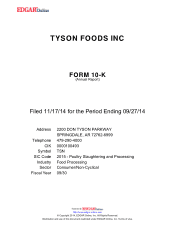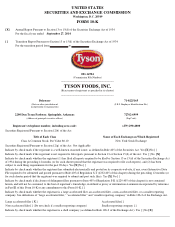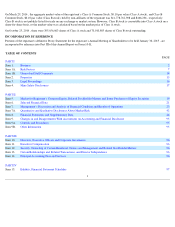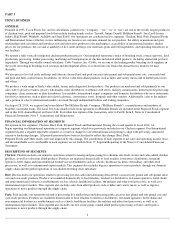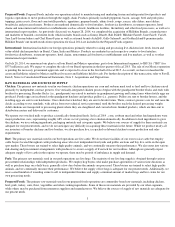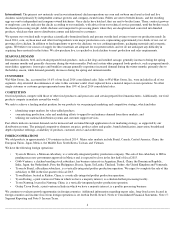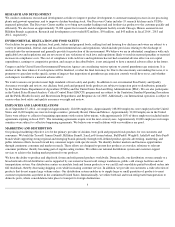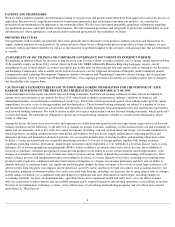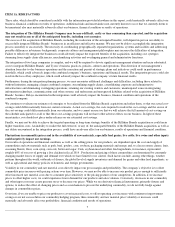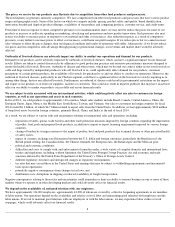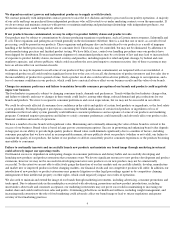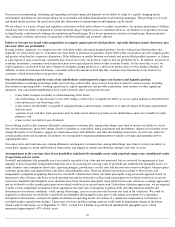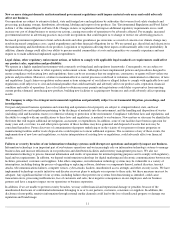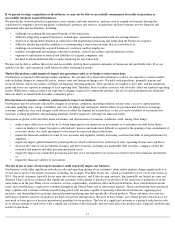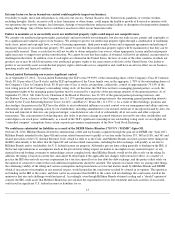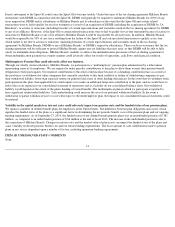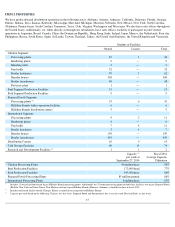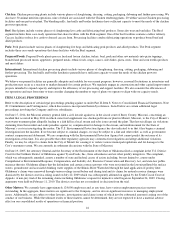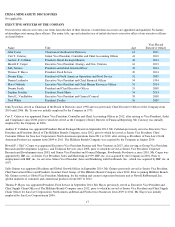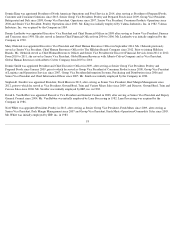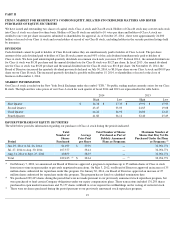Tyson Foods 2014 Annual Report Download - page 11
Download and view the complete annual report
Please find page 11 of the 2014 Tyson Foods annual report below. You can navigate through the pages in the report by either clicking on the pages listed below, or by using the keyword search tool below to find specific information within the annual report.
We depend on contract growers and independent producers to supply us with livestock.
We contract primarily with independent contract growers to raise the live chickens and turkeys processed in our poultry operations. A majority
of our cattle and hogs are purchased from independent producers who sell livestock to us under marketing contracts or on the open market. If
we do not attract and maintain contracts with growers or maintain marketing and purchasing relationships with independent producers, our
production operations could be negatively affected.
If our products become contaminated, we may be subject to product liability claims and product recalls.
Our products may be subject to contamination by disease-producing organisms or pathogens, such as Listeria monocytogenes, Salmonella and
E. coli. These organisms and pathogens are found generally in the environment; therefore, there is a risk that one or more, as a result of food
processing, could be present in our products. These organisms and pathogens also can be introduced to our products as a result of improper
handling at the further processing, foodservice or consumer level. These risks may be controlled, but may not be eliminated, by adherence to
good manufacturing practices and finished product testing. We have little, if any, control over handling procedures once our products have
been shipped for distribution. Even an inadvertent shipment of contaminated products may be a violation of law and may lead to increased risk
of exposure to product liability claims, increased scrutiny and penalties, including injunctive relief and plant closings, by federal and state
regulatory agencies, and adverse publicity, which could exacerbate the associated negative consumer reaction. Any of these occurrences may
have an adverse effect on our financial results.
In addition, we may be required to recall some of our products if they spoil, become contaminated, are tampered with or are mislabeled. A
widespread product recall could result in significant losses due to the costs of a recall, the destruction of product inventory and lost sales due to
the unavailability of product for a period of time. Such a product recall also could result in adverse publicity, damage to our reputation, and a
loss of consumer confidence in our products, which could have a material adverse effect on our business results and the value of our brands.
Changes in consumer preference and failure to maintain favorable consumer perception of our brands and products could negatively
impact our business.
The food industry in general is subject to changing consumer trends, demands and preferences. Trends within the food industry change often,
and failure to identify and react to changes in these trends could lead to, among other things, reduced demand and price reductions for our
brands and products. We strive to respond to consumer preferences and social expectations, but we may not be successful in our efforts.
We could be adversely affected if consumers lose confidence in the safety and quality of certain food products or ingredients, or the food safety
system generally. Prolonged negative perceptions concerning the health implications of certain food products or ingredients or loss of
confidence in the food safety system generally could influence consumer preferences and acceptance of some of our products and marketing
programs. Continued negative perceptions and failure to satisfy consumer preferences could materially and adversely affect our product sales,
financial condition and results of operations.
We have a number of iconic brands with significant value. Maintaining and continually enhancing the value of these brands is critical to the
success of our business. Brand value is based in large part on consumer perceptions. Success in promoting and enhancing brand value depends
in large part on our ability to provide high-quality products. Brand value could diminish significantly due to a number of factors, including
consumer perception that we have acted in an irresponsible manner, adverse publicity about our products (whether or not valid), our failure to
maintain the quality of our products, the failure of our products to deliver consistently positive consumer experiences or the products becoming
unavailable to consumers.
Failure to continually innovate and successfully launch new products and maintain our brand image through marketing investment
could adversely impact our operating results.
Our financial success is dependent on anticipating changes in consumer preferences and dietary habits and successfully developing and
launching new products and product extensions that consumers want. We devote significant resources to new product development and product
extensions, however we may not be successful in developing innovative new products or our new products may not be commercially
successful. To the extent we are not able to effectively gauge the direction of our key markets and successfully identify, develop, manufacture
and market new or improved products in these changing markets, our financial results and our competitive position will suffer. In addition, our
introduction of new products or product extensions may generate litigation or other legal proceedings against us by competitors claiming
infringement of their intellectual property or other rights, which could negatively impact our results of operations.
We also seek to maintain and extend the image of our brands through marketing investments, including advertising, consumer promotions and
trade spend. Due to inherent risks in the marketplace associated with advertising, promotions and new product introductions, including
uncertainties about trade and consumer acceptance, our marketing investments may not prove successful in maintaining or increasing our
market share and could result in lower sales and profits. Continuing global focus on health and wellness, including weight management, and
increasing media attention to the role of food marketing could adversely affect our brand image or lead to stricter regulations and greater
scrutiny of food marketing practices.
9

